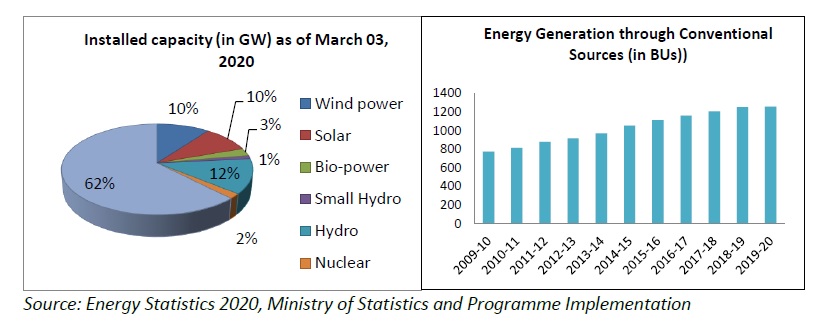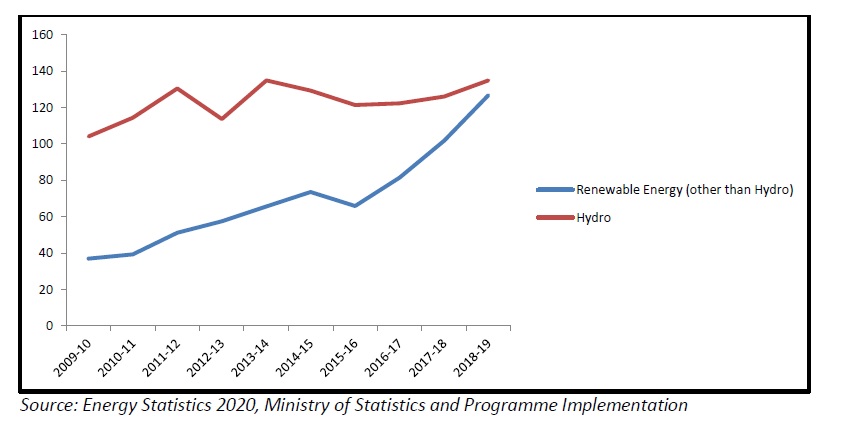
Dear Reader,
The 13th edition of the Spotlight explores the Indian power sector in the context of the Draft Electricity Amendment Bill 2020.
Developments in the Indian Power Sector & the Draft Electricity Amendment Bill
Are the steps sufficient?
INDIAN POWER SECTOR: KEY STATISTICS AND TRENDS
- Almost 62 percent of India’s power generation is still dependent on fossil fuels. Thus, a clean energy transition is contingent upon the planned decarbonisation of the Indian economy. However, the growth rate of conventional energy sources has been on a decline in the past few years of this decade, showing the emphasis on clean energy sources in India.

- By the growth rates of renewable energy (RE) sources, particularly solar and wind energy, the prospects of these sources of power generation seem bright, as shown in the figure below.

- The Government of India is also promoting these non-polluting sources of energy through various schemes and policies. These include schemes for a national Green Corridor, Solar Parks and Ultra Mega Solar Projects, Solar-Wind Hybrid Policy in addition to various state-level initiatives on the development of grid-connected as well as distributed RE generation.
THE BILL AT A GLANCE
On one hand, the power sector of India is at a cusp of transitioning to sustainable energy sources, while on the other there are several structural and legacy issues which have been affecting the operational and financial prospects of this sector. These include Aggregate Technical and Commercial losses (AT&C) of discoms, poor operational efficiency of generation, transmission and distribution utilities, political interference in the governance, sub-optimal revenue realisation and credit management, amongst others.
To address some of these issues, the Draft Electricity Amendment Bill was floated by the Ministry of Power for public comments. This section gives a snapshot of the major arguments for and against the changes proposed in the draft Bill.
The intent behind the Amendments
- Centralisation: Concentration of power in the hands of the Central Government for deliberation on crucial issues, including tariff, appointments to regulatory commissions, resolution of matters of contract enforcement
- De-stressing the States: Facilitating investments and commercial activities in the power sector by bringing in uniformity in a top-down manner
New Authority: Electricity Contract Enforcement Authority
- The Duplicity of Authorities: With existing regulatory commissions already dealing with contract-related issues, there arises a question about the need for a new Electricity Contract Enforcement Authority (ECEA)
- Need for a Specialised Authority: Owing to long-standing challenges of contract enforcement, the power sector is now being viewed as a nexus of contracts
New Models: Distribution Franchisee & Direct Benefit Transfer
- Privatisation of Discoms: Examples from Maharashtra have shown that private utilities can be effective if they have good quality equipment and efficient employees
- Progressive but Lacks Clarity: Direct benefit transfer (DBT) is a much-needed measure if cross-subsidies are to be gradually phased out. But the implementation should be designed by keeping in mind the ground realities
New Policies: Tariff and Renewable Energy
- Greater Sanctity for Tariff Policy: Tariff determination, previously ‘guided’ by the Tariff Policy, now has to adhere to the provisions of the new Tariff Policy which is awaiting Cabinet approval
- Legislative Push for RE: With the introduction of a new National RE Policy, there remains confusion regarding the existing basket of schemes and policies. There is a need for a larger discourse on energy rather than a focus on solar and hydro energy
WAY FORWARD
There is a need for institutionalisation of Cost-Benefit Analysis (CBA) and piloting of proposed interventions in a controlled regulatory environment (regulatory sandbox).
Additionally, adopting a holistic approach to the power sector is required for ensuring competitiveness in power-intensive sectors where it acts as a major input. For example, while subsidising power costs for agriculture its unintended impact on water resources should also be taken into account.
Note: For more details on this issue, please go through the comments submitted to the Ministry of Power on the Draft Electricity Amendment Bill by CUTS International which are available here: https://cuts-ccier.org/pdf/cuts-comments-on-draft-electricity-act-amendment-bill-2020.pdf
